Mandevilla is a popular plant known for its beautiful flowers and lush foliage. However, mandevilla leaves turning yellow and brown can be a common issue that gardeners face when growing mandevilla. If left untreated, this condition can lead to further damage and even death of the plant.
Understanding the cause of yellowing and browning leaves is crucial to maintaining a healthy mandevilla. Common causes include poor drainage, nutrient deficiencies, diseases, and pests. Identifying the root cause of the problem can help gardeners take appropriate action to treat and prevent further damage to the plant.
Key Takeaways
- Proper care and maintenance can prevent yellowing and browning leaves on mandevilla plants.
- Nutrient deficiencies, diseases, and pests are common causes of leaf issues.
- Identifying the root cause of the problem is crucial to taking appropriate action to treat and prevent further damage to the plant.
More on this category:
- Majesty Palm Turning Yellow and Brown
- Majesty Palm Leaves Turning Yellow and Brown
- Corn Leaves Turning Yellow and Brown
Understanding Mandevilla

Mandevilla is a tropical and subtropical vine that is commonly known as rock trumpet due to its trumpet-shaped flowers. It is a popular landscape plant that is often grown in hanging baskets or trained to climb trellises or walls. The plant is prized for its stunning blooms that come in shades of pink, red, and white.
Mandevilla vines are native to South and Central America and thrive in warm and humid environments. They require well-draining soil and plenty of sunlight to grow and flower. The plant is generally easy to care for, but it can be susceptible to a few problems, including yellowing and browning leaves.
Yellowing leaves on mandevilla vines can be caused by a variety of factors, including nutrient deficiencies, water stress, and pests. Iron deficiencies are common in mandevilla plants, and the younger leaves near the base of the vine are usually the first to turn yellow. The soil pH for mandevilla ought to be under 7. Any higher than a 7.0 and the plant will struggle to absorb iron from the soil.
Water stress can also cause mandevilla leaves to turn yellow. Overwatering or underwatering can both lead to yellowing leaves. It is essential to maintain consistent soil moisture levels to prevent this problem.
Browning leaves on mandevilla vines can be caused by fungal diseases, such as powdery mildew or sooty mold. These diseases are often the result of humid conditions or poor air circulation. Pests, such as spider mites or thrips, can also cause browning leaves.
Identifying Yellow and Brown Leaves
Mandevilla plants are known for their beautiful, lush foliage. However, if you notice that the leaves are turning yellow or brown, it could be a sign of an underlying issue.
Yellowing leaves are a common problem with Mandevilla plants and can be caused by a variety of factors. One of the most common causes is overwatering. When the soil is waterlogged, it can cause the roots to rot, which can lead to yellowing leaves.
In addition, underwatering can also cause yellowing leaves, so it’s important to find the right balance when it comes to watering your Mandevilla plant.
Another cause of yellowing leaves is nutrient deficiency. If your Mandevilla plant is not getting enough nutrients, the leaves may start to turn yellow. This can be corrected by fertilizing the plant with a balanced fertilizer.
Brown spots on the leaves of your Mandevilla plant can be a sign of a fungal infection. Fungal leaf spots are a common problem in Mandevilla plants and can be caused by a variety of fungi.
The disease appears as brown spots on the leaves, which can cause the leaves to curl and fall off. To prevent fungal leaf spots, it’s important to keep the leaves dry and to avoid getting water on the leaves when watering your plant.
Brown leaves can also be a sign of a fungal infection. Stem rot is a fungal disease that can cause the leaves and stems of your Mandevilla plant to turn brown and eventually die.
This disease is caused by a fungus that thrives in warm, humid conditions. To prevent stem rot, it’s important to keep the soil well-drained and to avoid overwatering your plant.
Mandevilla Leaves Turning Yellow and Brown – 7 Common Problems
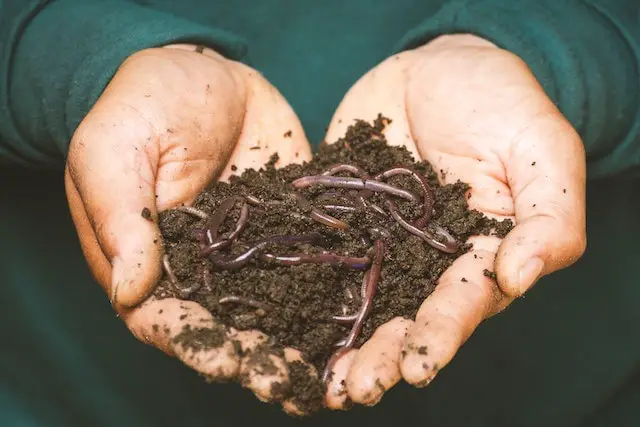
Mandevilla plants are known for their beautiful, vibrant flowers and lush foliage. However, if you notice that the leaves on your mandevilla plant are turning yellow and brown, it may be an indication of an underlying problem. Here are some common causes of yellowing and browning leaves in mandevilla plants:
1. Nutrient Deficiency
One of the most common causes of yellowing and browning leaves in mandevilla plants is a nutrient deficiency. Mandevilla plants require certain nutrients, such as iron and nitrogen, to grow and thrive. If the plant is not receiving enough of these nutrients, the leaves may begin to turn yellow and brown.
2. Lack of Nutrients
If it has been a while since you have fertilized your mandevilla plant, it may be time to provide it with fertilizer. Without enough nutrients, the plant may fail to perform vital biological functions, causing the leaves to turn yellow and brown.
3. Soil pH
The soil pH for mandevilla plants should be under 7. Any higher than a 7.0 and the plant will struggle to absorb iron from the soil. If the soil pH is too high, the plant may experience an iron deficiency, leading to yellowing and browning leaves.
4. Watering
Inconsistent watering, underwatering, and overwatering can all cause yellowing and browning leaves in mandevilla plants. It is important to water the plant consistently and avoid letting the soil dry out completely or become waterlogged.
5. Direct Sunlight
Mandevilla plants require bright, indirect sunlight to grow and thrive. If the plant is exposed to direct sunlight for too long, the leaves may begin to turn yellow and brown.
6. Environmental Stress
Environmental stress, such as extreme temperatures or high humidity, can also cause yellowing and browning leaves in mandevilla plants. It is important to keep the plant in a stable environment with consistent temperatures and humidity levels.
7. Poor Drainage
Poor drainage can also cause yellowing and browning leaves in mandevilla plants. If the plant is not draining properly, the roots may become waterlogged and begin to rot, leading to yellowing and browning leaves. Make sure the plant has proper drainage holes and is not sitting in water for too long.
Diseases and Pests Affecting Mandevilla
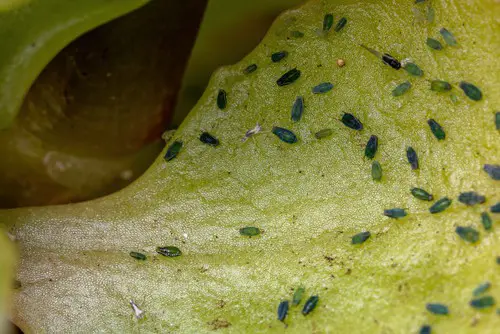
Mandevilla plants are susceptible to a variety of diseases and pests. Here are some common ones to watch out for:
1. Southern Wilt and Southern Blight
Southern wilt and southern blight are both caused by the soil-borne fungus, Sclerotium rolfsii. These diseases can cause wilting, yellowing, and brown leaves, as well as stem rot and plant death. The fungus can survive in the soil for years, so it’s important to remove infected plants and soil.
2. Fungal Attacks
Mandevilla plants can be attacked by various fungi that cause leaf spots, stem rot, and other issues. Fungal infections can be prevented by keeping the plant dry and well-ventilated. If a fungal infection does occur, it’s important to remove the infected leaves and treat the plant with a fungicide.
3. Botrytis Blight
Botrytis blight is a fungal disease that causes brown spots on the leaves and flowers of mandevilla plants. It thrives in cool, damp conditions and can quickly spread to other plants. To prevent botrytis blight, avoid overwatering and keep the plant well-ventilated.
4. Sooty Mold
Sooty mold is a black, powdery fungus that grows on the honeydew secreted by aphids and other sap-sucking insects. It doesn’t directly harm the plant, but it can block sunlight from reaching the leaves. To get rid of sooty mold, you need to get rid of the insects that are causing it.
5. Root Rot
Root rot is caused by overwatering and poor drainage. It causes the roots to rot, which can lead to yellowing and brown leaves. To prevent root rot, make sure the plant is in well-draining soil and only water it when the top inch of soil is dry.
6. Pests
Mandevilla plants can be attacked by various pests, including aphids, spider mites, and mealybugs. These pests can cause yellowing and brown leaves, as well as stunted growth and plant death. To get rid of pests, you can use insecticidal soap or neem oil.
Nutrient Requirements for Healthy Mandevilla
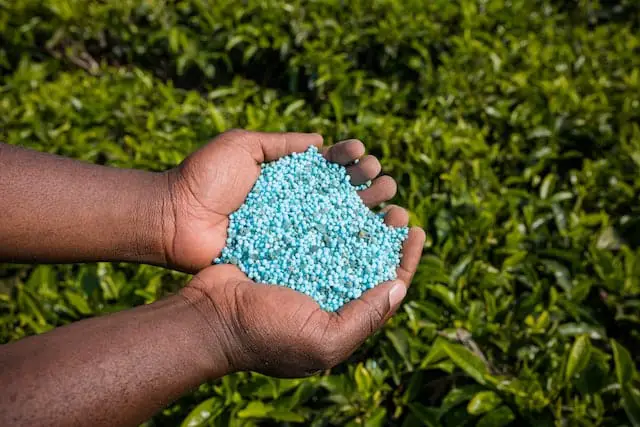
Mandevilla plants require specific nutrients to maintain healthy growth and vibrant foliage. Without these nutrients, the plant may struggle and become susceptible to diseases and pests. Here are the essential nutrients that mandevilla plants require:
1. Nitrogen
Nitrogen is a vital nutrient for mandevilla plants, and it is responsible for the plant’s overall growth and development. It is essential for the production of chlorophyll, which gives the leaves their green color.
Nitrogen deficiency can cause the leaves to turn yellow and eventually brown. To prevent this, mandevilla plants require a steady supply of nitrogen-rich fertilizer throughout the growing season.
2. Iron
Iron is another essential nutrient for mandevilla plants. It plays a crucial role in chlorophyll production and helps the plant absorb other nutrients. Iron deficiency is a common problem in mandevilla plants, and it can cause the leaves to turn yellow.
To prevent this, gardeners should ensure that the soil pH is below 7.0, as high pH levels can make iron less available to the plant.
3. Manganese and Zinc
Manganese and zinc are two micronutrients that mandevilla plants require in small amounts. They play a vital role in plant growth and development and help the plant absorb other nutrients. Manganese deficiency can cause the leaves to turn yellow, while zinc deficiency can cause stunted growth and yellowing of the leaves.
4. Fertilizers
To ensure that mandevilla plants receive the necessary nutrients, gardeners should use a balanced fertilizer with a ratio of 20-20-20. This fertilizer provides equal amounts of nitrogen, phosphorus, and potassium, along with other essential micronutrients.
Gardeners should apply the fertilizer every two weeks during the growing season to ensure healthy growth and vibrant foliage.
Proper Care and Maintenance of Mandevilla

Mandevilla is a beautiful flowering plant that requires proper care and maintenance for optimal growth and health. Here are some tips to help you keep your Mandevilla healthy and vibrant:
1. Watering
Mandevilla requires regular watering, especially during the growing season. The soil should be kept moist, but not waterlogged. Overwatering can lead to root rot and other problems. It is essential to ensure that the pot has proper drainage to prevent standing water.
2. Sunlight
Mandevilla prefers full sun to partial shade. It is best to place the plant in a location where it receives at least 6 hours of sunlight per day. However, it is important to protect the plant from direct sunlight during the hottest part of the day, which can cause leaf scorch.
3. Repotting
Mandevilla should be repotted every 2-3 years. When repotting, it is important to use a well-draining potting mix and a container that is one size larger than the current pot. Repotting should be done during the spring when the plant is actively growing.
4. Soil
Mandevilla prefers a well-draining soil mix that is rich in organic matter, such as peat moss. Adding sand to the soil mix can also improve aeration and drainage.
5. Air Circulation
Mandevilla requires good air circulation to prevent fungal diseases. It is important to avoid overcrowding the plant with other plants or objects.
6. Indoor vs. Outdoor Plant
Mandevilla can be grown both indoors and outdoors. When grown indoors, it is important to provide adequate sunlight and proper air circulation. When grown outdoors, it is important to protect the plant from cold temperatures and strong winds.
7. New Growth
Mandevilla produces new growth during the growing season. It is important to provide the plant with adequate nutrients, such as nitrogen, to promote healthy growth. Fertilize the plant every 2-3 weeks during the growing season with a balanced fertilizer.
Treatment and Prevention of Leaf Issues
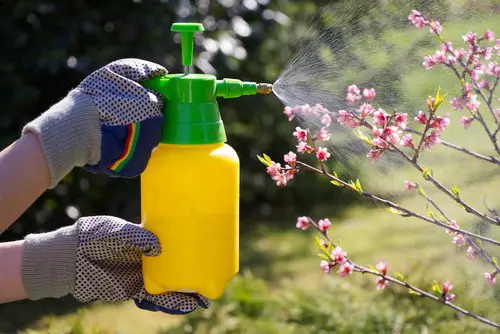
When it comes to treating and preventing leaf issues in Mandevilla plants, there are several options available. The best treatment option will depend on the specific issue affecting the plant. Here are some common treatment options and prevention methods to consider:
1. Fungal Diseases
Fungal diseases are a common cause of brown spots and yellowing leaves in Mandevilla plants. Fungal leaf spots, Botrytis blight, Sooty mold, and stem rot are the main fungal diseases for Mandevilla.
Several fungi can cause fungal leaf spots. The disease appears to be brown spots on the leaves. Severe infection can make the leaves curl and fall off. To treat fungal diseases, gardeners can use a fungicide such as Bonide Copper Fungicide or Copper Sulfate.
These products can help prevent the spread of the disease and protect the plant from further damage.
2. Insect Infestations
Insects such as spider mites, aphids, and whiteflies can cause yellowing and discoloration of Mandevilla leaves. To treat insect infestations, gardeners can use an insecticide such as Garden Safe Brand Ready-to-Use Garden Insect Killer.
This product is formulated to kill a wide range of common garden insects, including spider mites, aphids, and whiteflies. Additionally, gardeners can use neem oil or horticultural oil to help prevent future insect infestations.
3. Overwatering
Overwatering can also cause yellowing and wilting of Mandevilla leaves. To prevent overwatering, gardeners should only water the plant when the top inch of soil is dry. Additionally, gardeners should ensure that the plant is planted in well-draining soil and that the pot has adequate drainage holes.
4. Soil Issues
Soil issues such as nutrient deficiencies or pH imbalances can also cause yellowing of Mandevilla leaves. To prevent soil issues, gardeners should ensure that their plant is planted in nutrient-rich soil and that the soil pH is within the appropriate range for Mandevilla plants.
Additionally, gardeners can use a soil test kit to monitor soil pH and nutrient levels and adjust as needed.
5. Disinfecting Tools
Finally, it is important to disinfect any gardening tools used on Mandevilla plants to prevent the spread of disease. Gardeners can use a solution of one-part bleach to nine parts water to disinfect pruning shears, scissors, and other gardening tools.
By following these treatment and prevention methods, gardeners can help ensure healthy, vibrant Mandevilla plants with beautiful foliage.
Conclusion
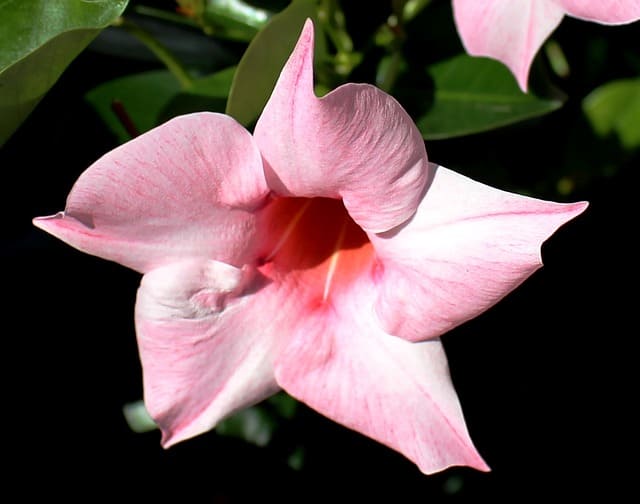
Mandevilla leaves turning yellow and brown can be a sign of various issues that can impact the health of the plant. Inconsistent watering, environmental stress, bacterial wilt, fungal attacks, and nutrient deficiencies are some of the most common causes of yellow and brown leaves in Mandevilla plants.
To prevent fungal diseases, it is essential to avoid overwatering and overcrowding of the plants. Good air circulation around the plant is also necessary to keep the leaves dry. Watering at the base of the plant can help prevent the leaves from getting wet.
Bacterial wilt is another cause of yellow and brown leaves in Mandevilla plants. Once the plant is infected, it is difficult to treat, and the best way to prevent this disease is to avoid planting Mandevilla in the same soil where other infected plants have grown.
Environmental stress can also cause yellow and brown leaves in Mandevilla plants. Exposure to direct sunlight, cold temperatures, and strong winds can cause stress in the plant, leading to leaf discoloration. Providing adequate shade and protection from the elements can help prevent environmental stress.
Nutrient deficiencies, such as iron deficiency, can also cause yellow leaves in Mandevilla plants. Adding iron-rich fertilizers to the soil can help prevent this issue.
Frequently Asked Questions
Why are my mandevilla leaves turning yellow and brown?
Mandevilla leaves can turn yellow and brown due to a variety of reasons, including inconsistent watering, nutrient deficiencies, pests, diseases, and environmental stress. If not addressed promptly, the leaves will eventually fall off, and the plant may die.
How do you fix yellow leaves on mandevilla?
To fix yellow leaves on a mandevilla plant, you should first identify the underlying cause. If the cause is inconsistent watering, you should water the plant regularly and make sure the soil is well-draining.
If the cause is nutrient deficiency, you should fertilize the plant with a balanced fertilizer. If the cause is pests or diseases, you should treat the plant with appropriate pesticides or fungicides.
How often should mandevilla be watered?
Mandevilla plants should be watered regularly, but not excessively. The frequency of watering depends on various factors, such as the size of the pot, the type of soil, the temperature, and the humidity. In general, you should water the plant when the top inch of soil feels dry to the touch.
How do I know if my mandevilla needs water?
You can tell if your mandevilla plant needs water by checking the moisture level of the soil. You can do this by sticking your finger about an inch deep into the soil. If the soil feels dry, the plant needs water. If the soil feels moist, the plant does not need water.
What does an overwatered mandevilla look like?
An overwatered mandevilla plant may exhibit several signs, such as yellowing leaves, wilting, root rot, and mold growth. The leaves may also become soft and mushy, and the plant may emit a foul odor.
If you suspect that your mandevilla plant is overwatered, you should reduce the frequency of watering and improve the drainage of the soil.
Why is the dipladenia leaves turning yellow and falling off?
Dipladenia, which is a close relative of mandevilla, may also experience yellowing leaves and leaf drop due to similar reasons, such as inconsistent watering, nutrient deficiencies, pests, diseases, and environmental stress.
To fix the problem, you should follow the same steps as for mandevilla, such as identifying the underlying cause and applying the appropriate remedy.

Hey, I’m Lisa and I’ve been an avid gardener for over 30 years. I love writing, talking and living in the garden! Feel free to connect with me on my socials below


